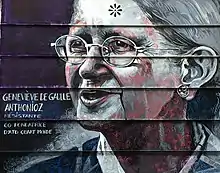Geneviève de Gaulle-Anthonioz
Geneviève de Gaulle-Anthonioz (25 October 1920 – 14 February 2002) was a member of the French Resistance and served as president of ATD Quart Monde. Her uncle was General Charles de Gaulle.

Geneviève de Gaulle-Anthonioz | |
|---|---|
 Work by Ernesto Novo at rue de Tourtille and rue Ramponeau, Paris 2014 | |
| Born | 25 October 1920 |
| Died | 14 February 2002 (aged 81) Paris, France |
| Nationality | French |
| Education | University of Paris University of Rennes |
| Occupation | President, ATD Quart Monde |
French Resistance
Geneviève de Gaulle joined the Resistance after the occupation of France in June 1940 and expanded its publicity networks, in particular that of Défense de la France. She was arrested by Pierre Bonny of the French Gestapo on 20 July 1943, imprisoned in Fresnes and deported to Ravensbrück concentration camp on 2 February 1944. Her fellow-prisoners included Jacqueline Fleury and Germaine Tillion.
In October 1944, de Gaulle was placed in isolation in the camp bunker. Heinrich Himmler made the decision to keep her alive to use her as a possible exchange prisoner. She was released in April 1945. In 1946 she married Bernard Anthonioz, a fellow resistance member and art editor, with whom she had four children.[1]
Fifty years after her release from Ravensbrück Geneviève de Gaulle-Anthonioz wrote the book La Traversée de la nuit (literally, The Crossing of the Night) about her life in the concentration camp and the mutual help among the women. It was translated to English and published by Arcade Publishing as The Dawn of Hope: A Memoir of Ravensbrück ISBN 1-55970-498-5, and re-published by Points in 1998 as God Remained Outside - An Echo of Ravensbruck.[2]
Career
As an active member and later president of the ADIR (Association of Deportées and Internées of the Résistance),[3] she filed lawsuits against Nazi war criminals, then took part in the rise of the political movement launched by her uncle, Rassemblement du peuple français (Rally of the French People).[4][5]
In 1958, de Gaulle-Anthonioz worked with the cabinet of André Malraux of which her husband was a member. She met Father Joseph Wresinski, then chaplain of the town of Noisy-le-Grand. The suffering of the families she met there revived those which she and other deportees had experienced.[5]
Starting as a permanent volunteer, de Gaulle-Anthonioz served as president of the movement ATD Quart Monde from 1964 to 1998.[3]
In 1987, she testified in the case of Klaus Barbie.[6][7]
In 1988 she became a member of the French Economic and Social Council, and for ten years fought for the adoption of a law against poverty. Deferred in 1997 due to dissolution of the French National Assembly, her law was enacted in 1998.
Legacy

On 21 February 2014, French President François Hollande announced that Mme. de Gaulle-Anthonioz would be interred in the Panthéon.[8]
She was interred there in May 2015[9] in a symbolic funeral. The coffin of Geneviève de Gaulle-Anthonioz at the Panthéon does not contain her remains but soil from her gravesite,[10] because her family didn't want her remains to be parted from those of her husband.[11]
Works
Decorations
- Médaille de la Résistance
- Croix de guerre 1939-1945
- Grand-Croix de la Légion d'honneur (Mme. de Gaulle-Anthonioz was the first woman to be awarded this rank).[12]
Other
- General Charles de Gaulle dedicated his Mémoires de guerre to her.[13]
See also
Bibliography
- Benoit Cazenave, Geneviève de Gaulle, in Hier war das Ganze Europa, Stiftung Brandenburgische Gedenkstätte, Editions Metropol Verlag, Berlin 2004.
References
- Auffray, Alain (17 October 1997). "Geneviève de Gaulle-Anthonioz. La resistant". Libération. Paris.
- Gaulle-Anthonioz, Genevieve (1998). The Dawn of Hope: A Memoir of Ravensbruck (also known as God Remained Outside - An Echo of Ravensbruck. Arcade Publishing.
- "Geneviève de Gaulle Anthonioz". ATD (Agir Tous pour la Dignité) Quart Monde.
- Profile, directmatin.fr; accessed 20 January 2016. (in French)
- Debaecker, Anne-Laure (2015-05-27). "Geneviève de Gaulle Anthonioz n'aurait guère aimé sa propre panthéonisation!". Le Figaro. Paris.
- Geneviève de Gaulle Anthonioz. "Geneviève de Gaulle Anthonioz". Babelio.
- "Extrait du témoignage de Geneiève de Gaulle lors du procès de Klaus Barbie le 9 juin 1987". Musée de la résistance en ligne.
- Hollande chooses two women for historic distinction, nytimes.com, 22 February 2014; accessed 25 August 2015.
- Angelique Chrisafis (27 May 2015). "France president Francois Hollande adds resistance heroines to Panthéon". The Guardian. Retrieved 25 August 2015.
- Paris celebrates WWII Resistance heroes added to Panthéon Archived 2016-03-05 at the Wayback Machine, news.yahoo.com; accessed 25 August 2015.
- "Les dépouilles des deux résistantes n'iront pas au Panthéon (Remains of the two resistants will not go to the Panthéon)". Le Dauphiné libéré. 13 March 2015. Retrieved 13 March 2015.
... elle avait manifesté le souhait d’être enterrée près de son mari Bernard à Bossey en Haute-Savoie. C’est donc le respect de ses dernières volontés qui a primé.
- AFP (20 February 2014). "Geneviève de Gaulle-Anthonioz: " le refus de l'inacceptable "". Le Point.
- Frédérique Neau-Dufour (2001). Geneviève de Gaulle-Anthonioz: l'autre De Gaulle. Paris: Editions du Cerf. p. 138. ISBN 9782204075770.
External links
- Related to the website of CIDEM (file .pdf)
- Discussion with Francoise Colpin
- The official site of ATD Quart Monde